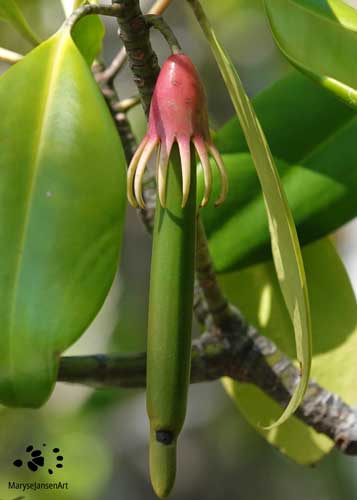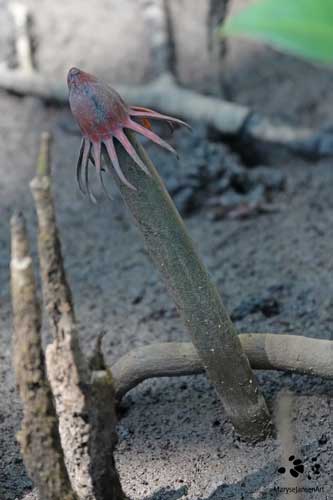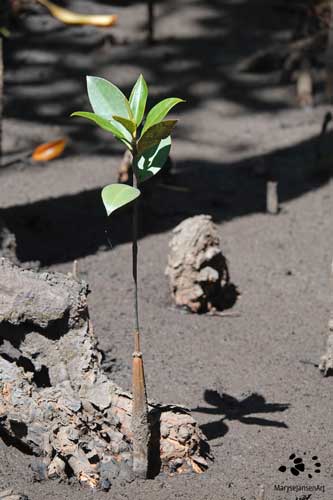Wildflower Photography with marysejansenart
Cup-shaped flowers, cigar-shaped fruits and knee-shaped roots

Table of Contents
Where to find an Orange Mangrove Forest
Each zone in a Mangrove Forest is dominated by one or two species. While the Grey Mangrove runs the show in the area the closest to the waterline, the Red Mangrove likes to line up just behind it. A little bit further away from the water’s edge is an area that only gets inundated during spring tides. Depending on the salinity of the soil in this area Yellow or Orange Mangroves may dominate, usually accompanied by another lot of Grey Mangroves.
In this post I will zoom in on the Orange Mangroves, more specifically the Bruguiera gymnorhiza. This species is known by the common names of Large-fruited Orange Mangrove, Large-leaved Orange Mangrove or even Black Mangrove. These trees prefer the less saline soils, such as can be found in river estuaries along Australia’s east coast, starting north of Clarence River in New South Wales, and spreading across the north to Darwin in the Northern Territory.
Salt is a difficult thing for a plant or tree to deal with, so not many species can survive in salty circumstances at all. But the Mangroves species each have developed their own way of dealing with it. The main strategy for Orange Mangroves is ‘salt exclusion’. This means that the salt is filtered out at root level, and thus prevented from entering the plant. Additionally, salt that does enter the plant is accumulated in older leaves and so discarded of when the leaves fall.
A special place!
Mangrove Forests are an amazing place! They belong to the most valuable ecosystems on earth and it is as if you can feel that when you walk there. There is a quietness and a buzz at the same time – which is hard to describe. The mangroves live in an incredible harsh environment and despite that they flourish and the place is full of life energy. The trees are not very tall and their thick canopies seem to muffle the sounds that come from outside the mangroves and break the wind, which creates that feeling of quietness. But there are sounds within the mangroves such as the cicadas, the bees and the birds which make it buzz.
I am enjoying a beautiful walk through a Mangrove Forest as I notice a high density of Orange Mangroves. I have not seen anything like it before as on other occasions I have visited mostly Grey Mangrove dominated places, where I spotted only a handful of Orange Mangroves. The Orange Mangroves are most easily recognised when they flower, which they are doing right now. You can find them flowering mainly between January and March, but also in other times of the year.
Orange Mangrove Life Cycle
Have a look at he flowers in the featured image! They grow at the base of the leaves and they are bright orange-red cup-shaped flowers with cream coloured petals. The flowers are about 4 cm long so definitely not too tiny to notice. And of course the colour stands out brightly against the dense foliage of dark green leaves. The large leaves have a glossy surface, are elliptic in shape and quite thick. They grow up to 20cm long and 7 cm wide.

I spot a flower that has something growing out of it that looks like a big, green cigar! This is the fruit! It is large, up to 20cm, but it only contains one seed! The seed germinates, while still attached to the tree. Eventually, the flower wilts and the ‘cigar’ drops to the ground. It lands upright, like a spear in the mud! From here, it quickly begins to grows roots and the seedling can begin to grow. Fascinating! And it is so amazing that I can see all these stages here, right in front of me!

But what if the seedling drops at high tide and lands in the water? Well, they are able to travel and survive in water for quite some time until they reach a suitable ground to take hold and grow on. It is an incredible clever system. The large fruit secures the seedling of nutrients while travelling. They travel horizontally in salt water and when they reach brackish water they are able to tilt to a vertical position with their roots ready to lodge in the mud! Once contact is made with the ground, they quickly begin to produce more roots to secure their foothold.

Preventing erosion and providing bush tucker
To be secure in an environment where they are subject to the forces of spring tides they need a strong root system. They develop so called cable roots which protrude above the ground intermittently and then go back under the surface again. These are called knee-roots and are also a great way to help you identify the species! The knee roots help the Orange Mangrove ‘breathe’ oxygen which is really scarce in the dense mud. The trunks are brown and have a rough, fissured bark and the trees can grow up to 20 metres tall.

Orange Mangroves serve an important function in the ecosystem. They provide stabilization of the mud with their root systems and are good wind breakers, thus preventing coastal erosion. Their leaf litter serves as food for the burrowing crabs, who keep the soil oxygenated and nutrient-rich in return. The trees form a habitat and provide food for many animals. Their fruit is also a bush tucker – which means it is eaten by Aboriginal Peoples. But not before it is baked, pounded and then rinsed and squeezed several times, so please do not try this yourself or you might get ill!
Join me on an interesting walk through 5 ecosystems, with some extra attention for the Orange Mangrove Forest along the way, in the latest episode of ‘Come for a walk in the Australian Bush’:
If you are interested in purchasing a print of ‘Orange Mangrove Flowers’ or would like to see what the image looks like on the various merchandise products, please head to my shop.


